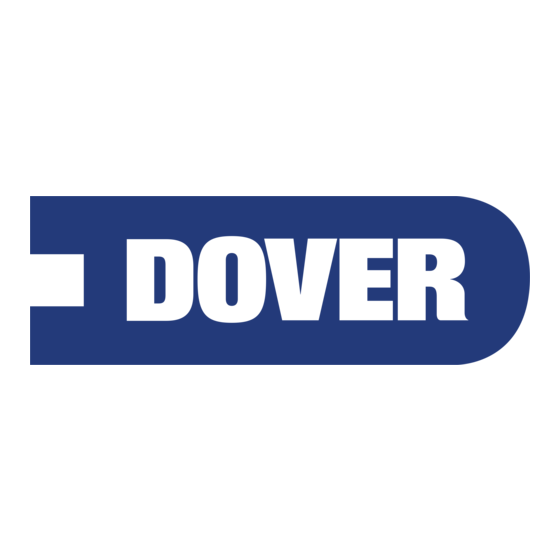Dover Blackmer DMX IV Handbuch - Seite 5
Blättern Sie online oder laden Sie pdf Handbuch für Industrielle Ausrüstung Dover Blackmer DMX IV herunter. Dover Blackmer DMX IV 15 Seiten. Air elimination system

4. SYSTEM CONSIDERATIONS (continued)
4.1
PRESSURE
SPIKES
EXPANSION CONSIDERATIONS
The DMX is designed to be installed on the suction side of
the pump where it would only be subject to a pressure
equivalent to the static head of the fluid in the supply tank.
The system engineer MUST insure that no pressure
increases due to pressure spikes or thermal expansion of
trapped liquid may occur inside the DMX.
WARNING
FAILURE TO LIMIT PRESSURE SPIKES
AND/OR PRESSURE INCREASES DUE TO
THERMAL EXPANSION OF PRODUCT
TRAPPED IN THE SYSTEM MAY LEAD TO
PRODUCT FAILURE (DMX AND RELATED
EQUIPMENT), PRODUCT SPILLAGE AND
OTHER POTENTIAL HAZARDS.
Failure to limit
pressure spikes.
DMX maximum pressure capability is 45 PSI (3.1 bar).
However, for system design consideration, the system
must be designed so that in normal operating conditions
(which may include fast closing of nozzle, thermal
expansion of liquid trapped in the system), the maximum
pressure inside DMX must remain below 30 PSI (2 bar).
In a piping system design that does not allow the suppres-
sion of spikes or does not have a provision to handle ther-
mal expansion, a spare volume of air must be trapped in
a dedicated area (hereafter called expansion tank).
The compression of air trapped in the expansion tank
will limit the maximum pressure inside DMX to an accep-
table level.
For thermal expansion of trapped liquid, the expansion
tank capacity must be take into account the maximum
volume of liquid trapped in the system, the maximum
increase of temperature of this liquid and the worst case
fluid expansion properties. For calculation purposes, the
starting pressure in the expansion tank has to equal the
minimum pressure measured in the DMX in full flow
conditions.
The system engineer must ensure that the capacity of
the expansion tank will limit the maximum pressure in
the DMX in case of pressure spikes and/or thermal
expansion of trapped liquid.
Blackmer offers an external DMX expansion tank, to be
implemented by the installer close to DMX see NT 201B-
F00 for details.
External expansion tanks must be installed in a location
where it will not fill with liquid once the system is fully pri-
med. Install and pipe the external expansion tank to the
DMX body using the ¼'' NPT port opposite to the
connection of the scavenging line. Use piping no less
than 1 foot (0.30 m) long and a minimum O.D. of ¼''. The
line connecting the expansion tank to the DMX must
have a minimum 3% continuously rising slope.
NT 201B-A00 04.06 DMX IV Air elimination system e
AND
THERMAL
5/15
4.2 DMX AIR ELIMINATION SYSTEM PRIMARY
FUNCTIONS
DMX systems have three primary functions, with secon-
dary functions :
• Flowrate control
• Priming
• Setting of High and Low flowrates
• Setting of High flowrate
• Setting of flowrate and engine speed acceleration
• Air Elimination & separation
• Stop flow when meter is no longer supplied with
air free liquid
• Provide air free and vapor free fluid delivery for
metered applications.
• Fluid Control
• Safety of operation when pumping against closed
discharge valve
• Liquid handling from DMX to Flow Detector
• Provide strained liquid to the pump
4.3 DMX - PRIMING PHASE
Refer to DMX IOM for more details on the priming cycles
of DMX.
Priming is either done through the gravity loading of the
pump and DMX or through the use of the vacuum pro-
duced by the DMX venturi option.
When the priming requires the operation of the DMX
venturi option, port 6 of the ACP should be connected to
the venturi inlet, as shown on Figure 1.
If the venturi is not needed to prime DMX, clog port 6 of
the ACP.
Refer to the DMX IOM to identify whether or not the
DMX venturi option is needed to prime DMX.
At the end of the priming phase, DMX will allow the air
pressure to build on the air relief valve of the pump.
To prevent pressure spikes in the system during this star-
ting cycle, the air flow going from the DMX to the pump
relief valve is restricted.
AIR LEAKAGE FROM THE DMX TO THE PUMP RELIEF VALVE
WILL NOT BE COMPENSATED BY EXTRA FLOW COMING FROM
DMX AND WILL CREATE SYSTEM FAILURE : "NO PRIMING".
Most common leakage sources are :
• Leaking connections : quick connect fittings have
been known to leak under cold weather conditions.
• Use of shuttle valve: leakage between the input ports
of ball type shuttle valves is common. Ball type shuttle
valves rely more on flow than pressure to shift.
• Use of pneumatic distributor.
The connection between DMX port #4 and the pump air
relief valve must be a direct line with no side connections.
Quick fit connections are not allowed to connect the DMX to
the pump relief valve. No accessories are allowed to be
installed between the two connection ports. The only excep-
tion is the use of pressure gauges when troubleshooting.
Make sure that the installation of a pressure gauge does
not lead to leaks on the line going from the DMX to the
pump relief valve when troubleshooting.
NOTICE :
